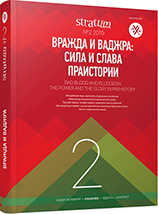Предметы вооружения позднего бронзового века из мастерских литейщиков поселения Талдысай в Центральном Казахстане
Late Bronze Age Weapons from Foundry Workshops of Taldysay Settlement, Central Kazakhstan
Author(s): Antonina S. Yermolayeva, Sergei V. Kuzminykh, Jang-Sik Pak, Yekaterina V. DubyaginaSubject(s): History, Archaeology, Economic history
Published by: Издательский дом Stratum, Университет «Высшая антропологическая школа»
Keywords: Central Kazakhstan; Late Bronze Age; Zhezkazgan-Ulytau mining and smelting center; Taldysay; workshops; heating and copper-smelting structures; ore; copper; casting molds; arrowheads;
Summary/Abstract: The paper provides technological and morphological analysis of various copper arrowhead types from the LBA site; those of the Early Alakul’ period with tubular sockets, and one more with internal socket, were cast in molds and then forged. The cast arrowhead with narrow blades is attributed to the Alekseevskiy-Sargary culture. Further, the casting mold of another arrowhead type is discussed to represent the Petrovka-Nurtay metalworking tradition. Hence, manufacturing of striking points for the ranged weapons seems to have taken place here, in Taldysay, throughout the 2nd millennium BC. The Zhezkazgan-Ulytau copper ores were melted in workshops equipped with specialized furnaces. Metal was poured into the molds of talc or those of baked clay, to make tools and utensils and decorations, such as knives, pin punches, chisels, awls, needles, staples, and beads. Pure copper casting was the reason why forging technique has been used for a very long time throughout the Asian area of the Eurasian Metallurgical Province.
Journal: Stratum plus. Археология и культурная антропология
- Issue Year: 2019
- Issue No: 2
- Page Range: 109-120
- Page Count: 12
- Language: Russian
- Content File-PDF

